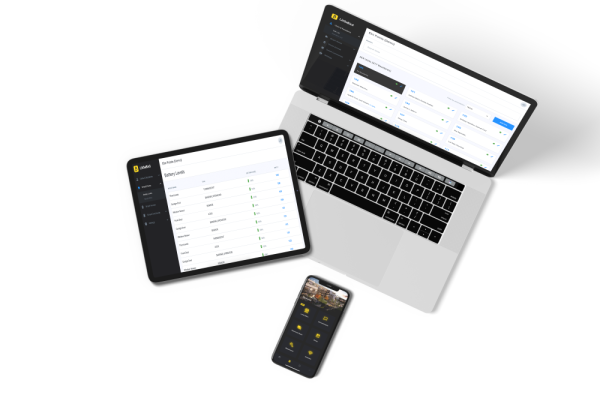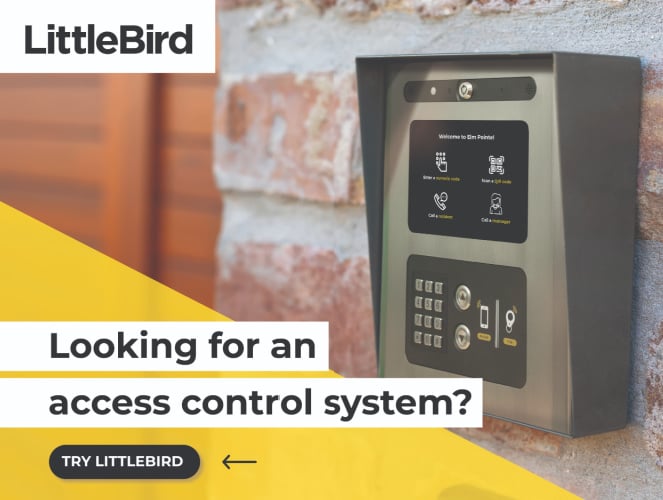What You Need to Know About Apartment Access Control Systems
Residents and property managers want two things more than anything 1) to feel safe and secure and 2) a convenient access control system that is simple to navigate.
This is why choosing the right access control system that best addresses your multifamily needs of security, resident experience, and operational functionality is so crucial.
In this article, you will learn…
- What is an apartment access control system
- Types of apartment access control systems
- How an access control system works
- Benefits of an apartment access control system
- How to choose the best apartment access control system
What is an apartment access control system?
Apartment access control is the act of limiting property and building access – often through automation – to only verified staff, residents, guests, and approved visitors. While there are several access control methods to choose from, they’re all unified in purpose – to create a convenient experience and safe environment for the property’s occupants.

While controlled gate access is typically included in an apartment building’s overall access control system, this article will focus only on controlled access to the property’s building(s).
Types of apartment access control systems
Truth be told, there isn’t a universal access control system that can be implemented the same exact way for all multifamily communities. Fortunately, providers like LittleBird can help dealers, property owners, and property management create customized plans for their property’s unique needs.
The first step in creating an efficiently controlled access apartment is knowing what solutions are available.
There are 5 apartment access control systems commonly used today including:
- Keypad readers
- Key cards and fobs
- Mobile access control
- Cloud-based access control
- An apartment video intercom with door release
Keypad readers
Keypad readers use a pin or password to unlock a door. They often used to lock amenity spaces like the rooftop or a gym. This access control method offers property managers optimal security since there isn’t a physical credential like a key that can be handed off, copied, or lost. However, security protocols can be breached if a resident shares a keypad reader pin.
Some keypad devices also have mobile app entry capabilities. This allows residents to open their doors by simply tapping on an app on their smartphone or tablet.
Cloud-based access control
Cloud-based access control systems work by storing credentials in the cloud rather than utilizing an expensive on-site server.

This control system allows both residents and property staff to unlock doors from anywhere in the world by using any internet-connected device. This is especially convenient since modern residents always have one internet-connected device with them – their smartphone. The property staff can also review entry logs, manage access permissions, and update the resident directory remotely through an online management portal.
Key cards and key fobs
If you’ve ever stayed in a hotel, you’ve likely used either a swipe or proximity key card to access your room. Key fobs provide the same functionality as proximity key cards, however, are the preferred choice for residents since they are more convenient to carry around (often on their keychains).
How keycard and fob access control systems work for apartment buildings:
- All residents and property staff receive a proximity key card or fob that is embedded with credentials that grant access to specific entry points.
- The resident simply presents the card to an RFID door reader, which scans and validates the user's credentials.
- Once verified, the access reader sends signals to the electric or magnetic door to unlock and allow the resident to pass through.
Mobile access control
Mobile access control systems often require residents to download an approved app to a mobile device – i.e. a smartphone, tablet, or another smart device – which validates their identity for keyless door entry. When they approach a door reader, they activate the ‘unlock’ function on the app to have access rights. A recent study found that nearly 56% of surveyed residents wish their multifamily community offered mobile access control.
.jpg?width=1200&height=634&name=Blank%201200%20x%20634%20(1).jpg)
Mobile access readers are a popular, modern choice for four reasons:
- Mobile access control creates an elevated, touchless resident experience.
- Mobile access control systems save time for property staff by limiting credential-related issues.
- Mobile access control eliminates the maintenance cost of physical credentials.
- Mobile access control is compatible with several technologies including Wifi, Bluetooth Low Energy (BLE), or Near field communication.
Apartment video intercom system with door release
While intercom systems are a tried and true access control system for apartments, video capabilities create an even more robust solution.
Watch how LittleBird’s video intercom systems works for residents and visitors:
Resident video intercom interaction:
Residents can easily validate their credentials by simply walking up to the intercom and entering a pin code, scanning a QR code, or using a mobile device. Once access is granted, the door release mechanism is signaled and unlocks the door.
Visitor video intercom interaction:
When visitors visit a property, they can look up the resident they wish to see in the directory and press the corresponding button to activate a 1-way video call. The resident can either answer the video call on their smart device to see who's at the gate or screen who's at the gate through a phone call. If the resident chooses to let the visitor in, they press a ‘door open’ button to enact the door release mechanism.
Interested in Apartment Access Control?
How does an access control system work?
From the strictest to the simplest apartment access control system, all share four main components.
The four main components of an access control system are the access controller, the access reader, credentials, and a door release mechanism. They are the foundation of an effectively controlled access system.
1. Access controller
The access controller, also known as the access control panel, is the brain of the entire system. Historically, the controller was a physical item that was commonly tucked away near the server of the building. Since the introduction of cloud-based software, property owners have been eager to adopt it since it may be managed anywhere that has Internet access.
How do access controllers work
Whenever a resident or staff member scans their credential at an access reader, the control panel receives an encrypted tag number. The control panel then verifies that the credential matches the information in its database. If the same information is found, the system sends a signal to activate the door release mechanism.
2. Access reader
Access readers are installed at one side or both sides of any given controlled apartment’s entry point. Typically they are placed on the outside of a locked area, however, some cases require a “request to exit” sensor to be placed inside the room as well.
The access control reader is the device that the resident interacts with a key card, key fob, mobile app, or another access credential. The reader scans the information tag in the resident’s credential and sends the encrypted information to the access controller for authentication.
3. Credentials
There are several different ways residents may present their credentials, depending on the access control system managed by their multifamily community. Regardless of the form, the access credentials’ purpose is to store the resident or staff members' unique access permissions.
A few common access controls credentials are…
- Key cards and key fobs
- Pins and passcodes
- Mobile app
4. Door release mechanism
Door release mechanisms found in apartments are either magnetic or electronic. The controller communicates with the door lock to “unlock” or “deny access” depending on the requester’s access permissions.
Benefits of an apartment access control system
Reduce theft and damage.
By making it more difficult for unauthorized individuals to get into your community, you reduce the opportunities for vandalism, squatting, littering, theft, and other potential damage to the property.
Quickly gather evidence with a full-access report log.
In the event of an incident requiring documentation of community access, you can see a full log of all entry point access, allowing you to quickly discover who entered the community or amenity at any specific time.
Save staff time through cloud-based access management.
Community staff can readily change settings for any gate, area, or individual through a web portal, eliminating time-consuming steps like scheduling a technician or manually adding a new resident to the intercom directory.
A convenient experience for property staff, residents, and guests.
Residents have a greater sense of control and safety with the ability to open doors, manage guests, and answer intercom calls from their smartphones.
Choosing the best apartment access control system
Finding the right access control system for your property that will meet all your needs can be tricky. LittleBird’s robust smart access solution helps make your decision easy with a solution that makes every aspect of residential community living smart and simple for both residents and property staff.
At the center of the LittleBird experience is a unified app for residents that helps promote comfort, convenience, and peace of mind. The LittleBird Living app (available in both IOS and Android app stores) gives residents a seamless experience by allowing them to….
- Manage visitor access
- Send virtual keys to guests
- Answer video intercom calls
- Open doors with touchless, smart devices
- Interact with other built-in community features
LittleBird also offers a management portal that gives property staff the ability to…
- Update resident information
- Audit the traffic of access points
- Manage access permissions for residents

-1.png?width=5935&height=1114&name=NEW%20LU%20%E2%80%93%20Long%20Logo%20%E2%80%93%20Dark%20(1)-1.png)
Comments